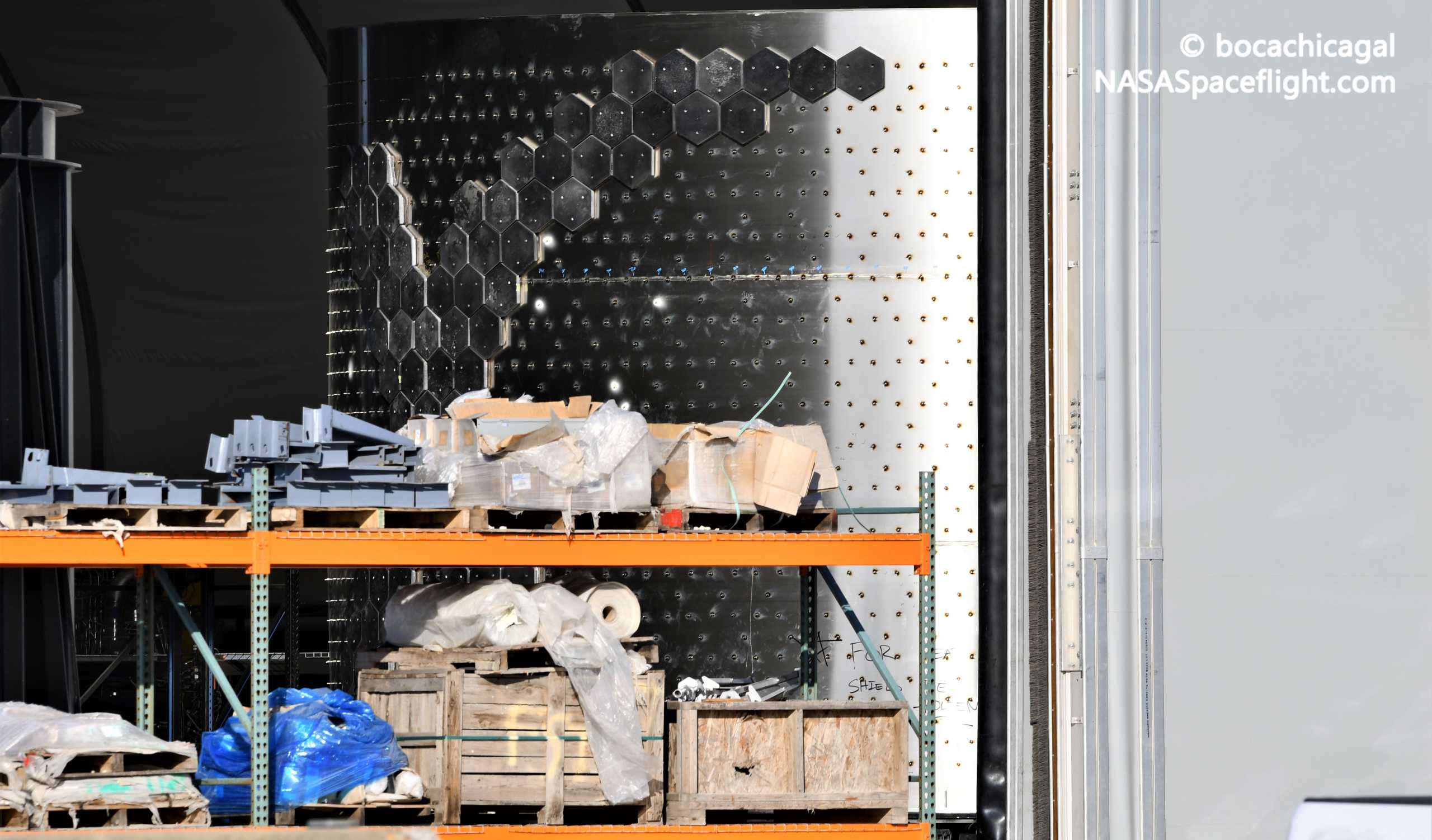
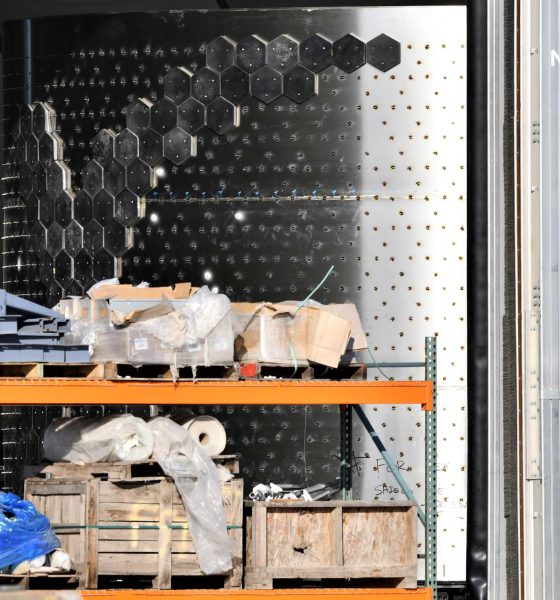
News
SpaceX installs orbital Starship heat shield prototype with robots
SpaceX has begun large-scale Starship heat shield installation tests with the help of robots delivered last month in a sign that the company has already begun preparing for the rocket’s first orbital flight test campaign.
Designed to eventually replace SpaceX’s workhorse Falcon 9 and Falcon Heavy launch vehicles, Starship is a fully-reusable two-stage rocket powered by methane and oxygen-fueled Raptor engines. Just like Falcon 9, Starship’s first stage (known as Super Heavy) will launch the combined spacecraft and upper stage to an altitude of 70 to 100 km (40-65 mi) and velocity of ~2.5 to 3 kilometers per second (1.5-1.9 mi/s). Super Heavy will separate, boost back towards land, and either land back at the launch pad or on a floating platform.
SpaceX already has extensive experience launching, landing, and reusing orbital-class rocket boosters thanks to Falcon 9 and Heavy, which have completed 57 landings and been reused 39 times in less than five years. The Starship upper stage, however, will have to survive orbital-velocity atmospheric reentries some 3 to 5 times faster and exponentially more energetic than Super Heavy boosters. To do so routinely while keeping Starship cost and complexity low and reusability high, SpaceX will have to develop an unprecedentedly effective heat shield that is easier to install, maintain, and reuse than anything that has come before it.
As with all SpaceX programs, the company began Starship heat shield installation development as soon as possible, installing a handful of tiles (presumably early-stage prototypes) on Starhopper as far back as H1 2019. This continued with small hexagonal tile installation tests on Starships SN1, SN3, SN4, SN5, and SN6 throughout 2020. While those coupon tests obviously didn’t involve orbital-class reentry heating or buffeting, they were still useful to characterize the mechanical behavior of heat shield tiles under the stress of cryogenic propellant loading, Raptor static fires, and hop tests.
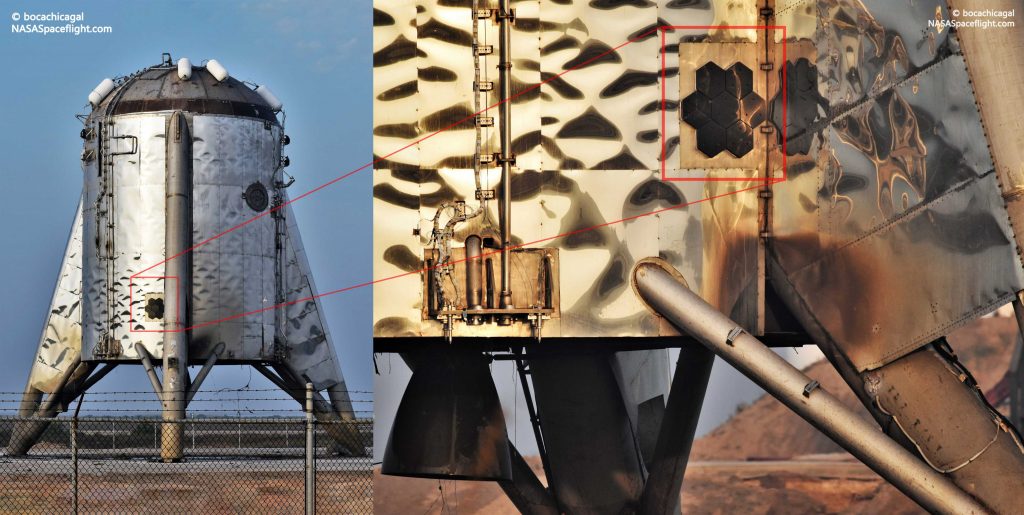
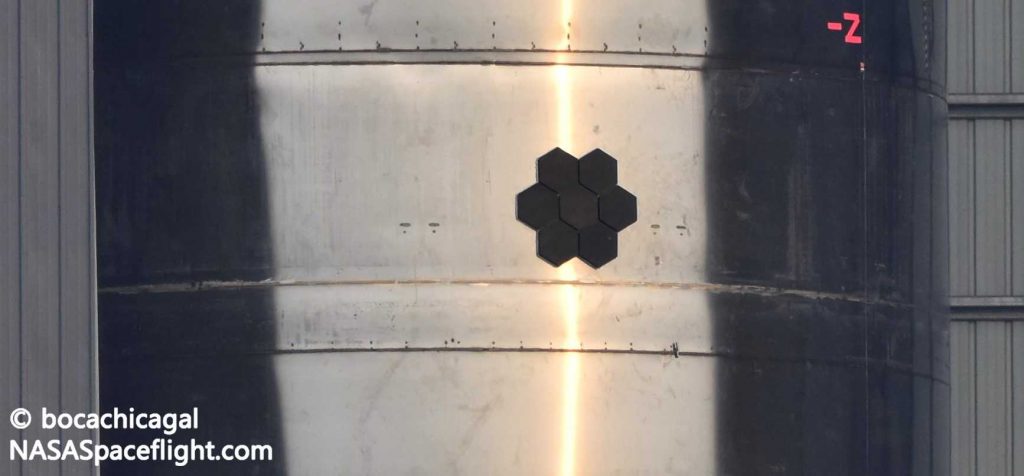
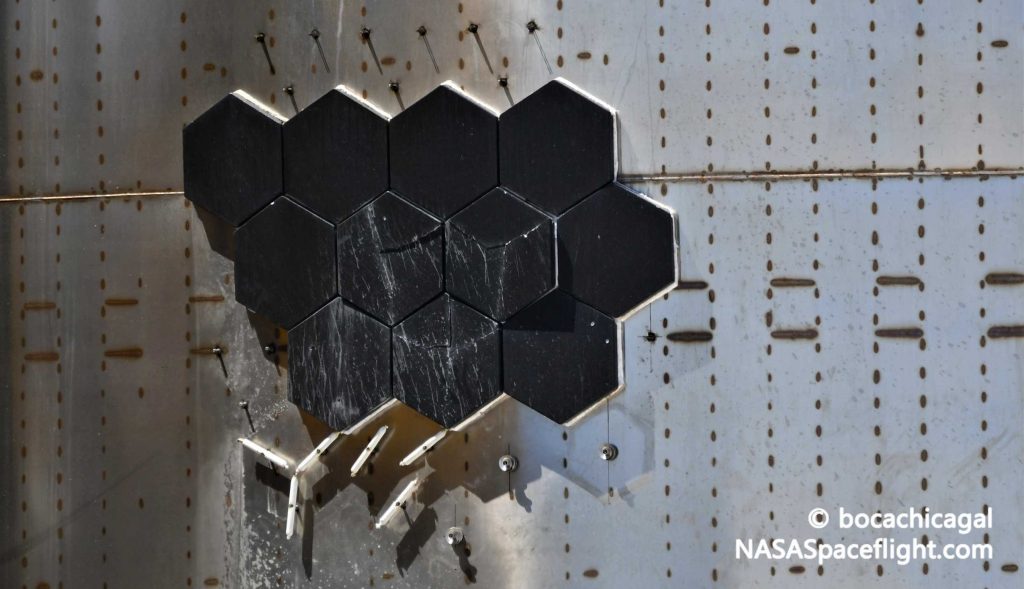
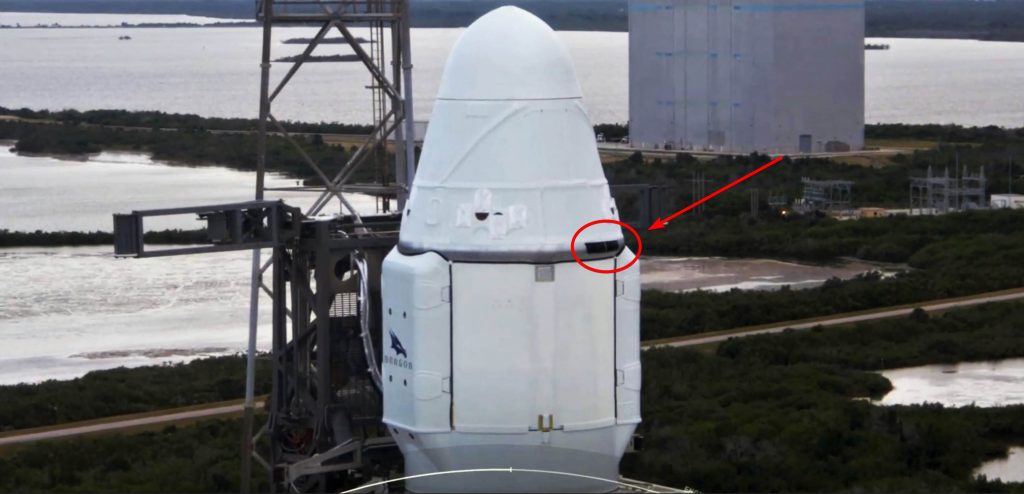
In 2019, SpaceX even tested a few ceramic Starship heat shield tiles on an orbital Cargo Dragon mission for NASA. The fact that no more orbital Cargo or Crew Dragon tests were acknowledged seems to suggest that the demonstration was a success, proving that the tiles can stand up to the stresses of reentry from low Earth orbit (LEO).
Behind the scenes, SpaceX is assuredly performing extensive laboratory-style tests with tiles and an agreement signed with NASA Ames Research Center confirmed that the company is using the facility’s arcjet to physically simulate the conditions of orbital-velocity reentry. Tests on the scale of a full Starship, however, are an entirely different story.
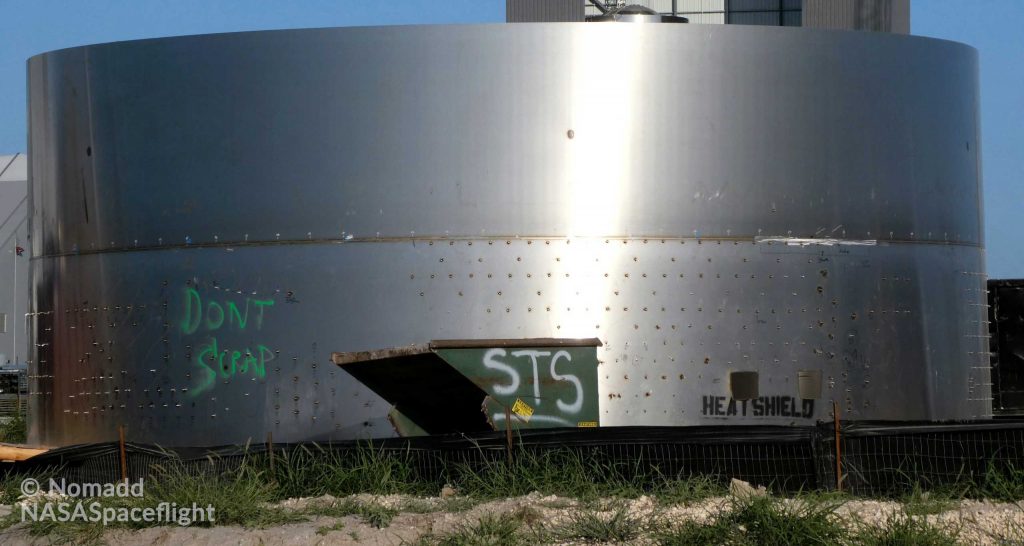
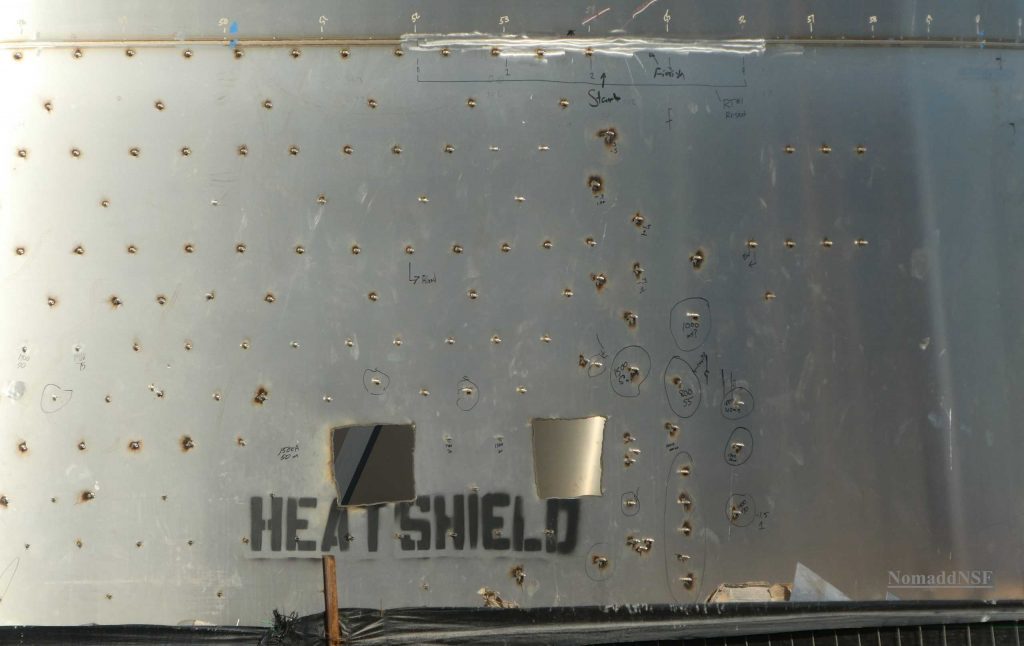
The first signs of large-scale heat shield installation testing appeared on July 9th when local resident and photographer Andrew Goetsch (Nomadd) captured photos of a test coupon covering half of an entire steel Starship ring. In April 2020, CEO Elon Musk confirmed on Twitter that the current design involved affixed heat shield tiles directly to Starship’s steel hull with steel studs. It’s unclear how exactly the company is installing steel studs directly onto the ~4mm (0.15 in) thick skins of a pressure vessel or if an off -the-shelf solution was available but Nomadd’s July 9th photos explicitly show the process required to refine the settings on the mystery stud installer.
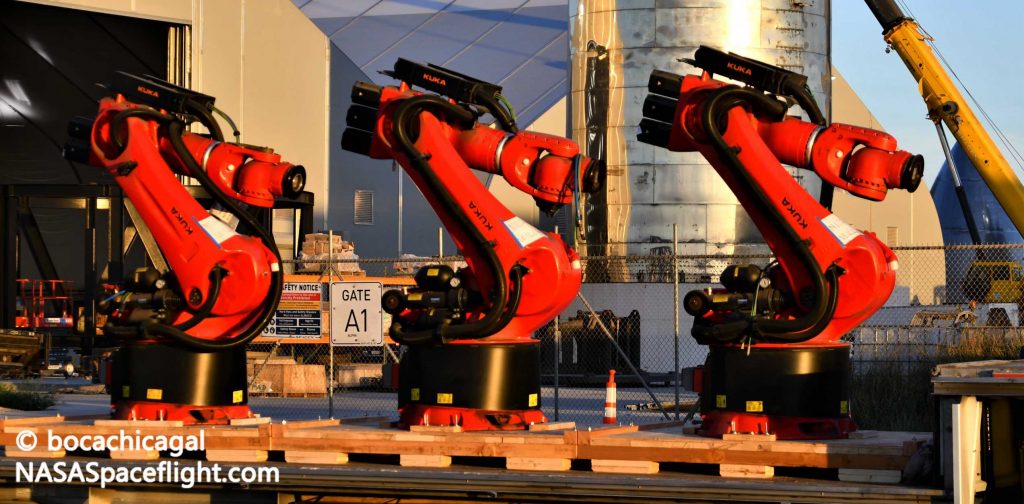

One month after Nomadd’s spotting, three weeks after a robot delivery, and five days after one of those robots – labeled “HEAT SHIELD – was spotted in action, the first large-scale heat shield installation test article was spotted inside one of SpaceX’s several production tents. The team involved clearly had some fun with the process, installing the tiles in the form of a SpaceX “X”.
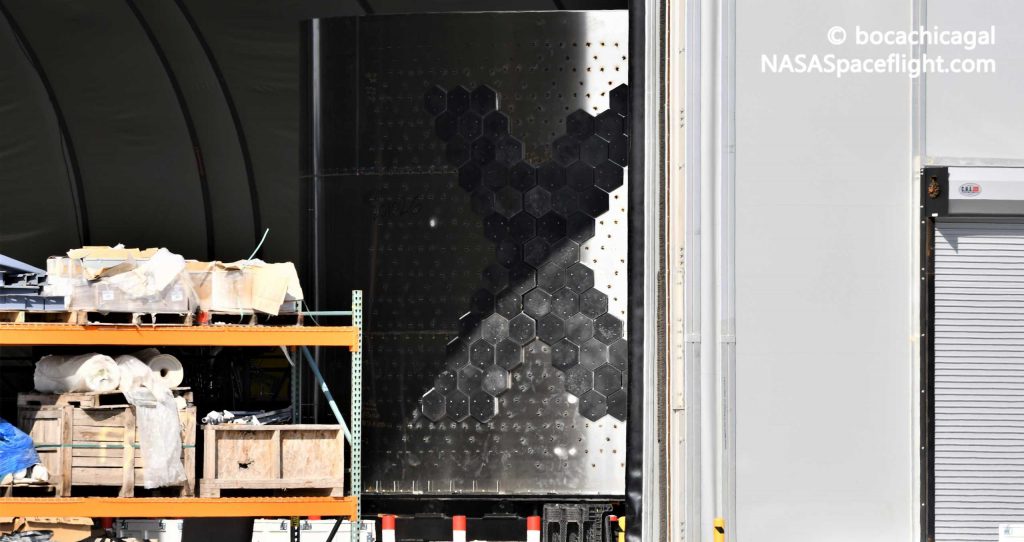
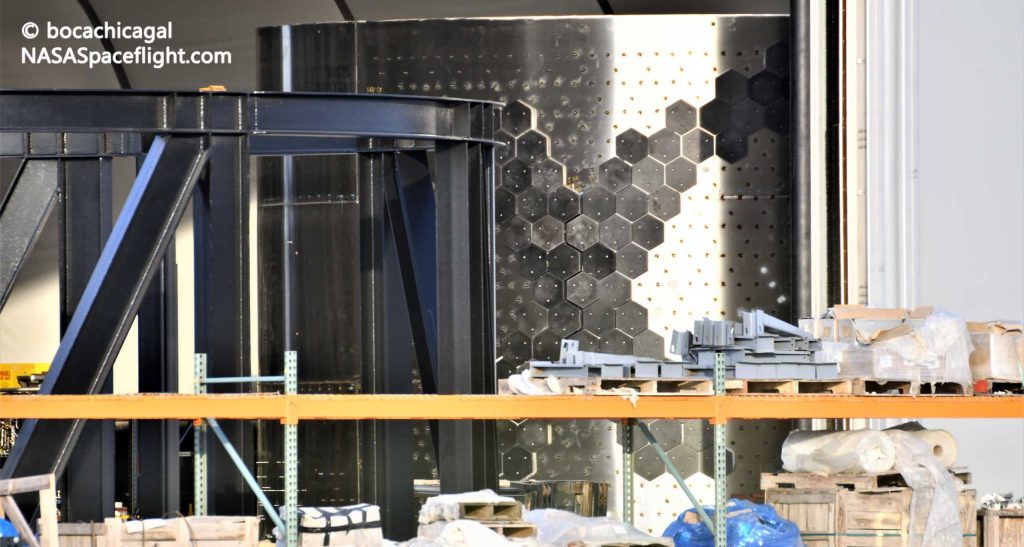
In retrospect, robots could be a perfect solution for the affordable, high-volume installation of the thousands of heat shield tiles a single Starship will need. Once tolerances are high enough, it’s conceivable that multiple different Starship sections could be individually outfitted with studs and heat shield tiles by robot, inspected by humans, and joined together to form a complete Starship. Humans would likely need to manually install a gap of tiles around the weld lines of those final sections, but the manual installation work would be reduced to a minimum while keeping the required infrastructure dead simple.
Ultimately, a great deal of work remains before SpaceX can even begin to feasibly attempt orbital Starship test flights, but it’s hard not to get excited by the fact that some of that preparatory work has already visibly begun in South Texas.
Check out Teslarati’s Marketplace! We offer Tesla accessories, including for the Tesla Cybertruck and Tesla Model 3.

Elon Musk
Starlink achieves major milestones in 2025 progress report
Starlink wrapped up 2025 with impressive growth, adding more than 4.6 million new active customers and expanding service to 35 additional countries, territories, and markets.

Starlink wrapped up 2025 with impressive growth, adding more than 4.6 million new active customers and expanding service to 35 additional countries, territories, and markets. The company also completed deployment of its first-generation Direct to Cell constellation, launching over 650 satellites in just 18 months to enable cellular connectivity.
SpaceX highlighted Starlink’s impressive 2025 progress in an extensive report.
Key achievements from Starlink’s 2025 Progress
Starlink connected over 4.6 million new customers with high-speed internet while bringing service to 35 more regions worldwide in 2025. Starlink is now connecting 9.2 million people worldwide. The service achieved this just weeks after hitting its 8 million customer milestone.
Starlink is now available in 155 markets, including areas that are unreachable by traditional ISPs. As per SpaceX, Starlink has also provided over 21 million airline passengers and 20 million cruise passengers with reliable high-speed internet connectivity during their travels.
Starlink Direct to Cell
Starlink’s Direct to Cell constellation, more than 650 satellites strong, has already connected over 12 million people at least once, marking a breakthrough in global mobile coverage.
Starlink Direct to Cell is currently rolled out to 22 countries and 6 continents, with over 6 million monthly customers. Starlink Direct to Cell also has 27 MNO partners to date.
“This year, SpaceX completed deployment of the first generation of the Starlink Direct to Cell constellation, with more than 650 satellites launched to low-Earth orbit in just 18 months. Starlink Direct to Cell has connected more than 12 million people, and counting, at least once, providing life-saving connectivity when people need it most,” SpaceX wrote.
News
Tesla Giga Nevada celebrates production of 6 millionth drive unit
To celebrate the milestone, the Giga Nevada team gathered for a celebratory group photo.

Tesla’s Giga Nevada has reached an impressive milestone, producing its 6 millionth drive unit as 2925 came to a close.
To celebrate the milestone, the Giga Nevada team gathered for a celebratory group photo.
6 million drive units
The achievement was shared by the official Tesla Manufacturing account on social media platform X. “Congratulations to the Giga Nevada team for producing their 6 millionth Drive Unit!” Tesla wrote.
The photo showed numerous factory workers assembled on the production floor, proudly holding golden balloons that spelled out “6000000″ in front of drive unit assembly stations. Elon Musk gave credit to the Giga Nevada team, writing, “Congrats on 6M drive units!” in a post on X.
Giga Nevada’s essential role
Giga Nevada produces drive units, battery packs, and energy products. The facility has been a cornerstone of Tesla’s scaling since opening, and it was the crucial facility that ultimately enabled Tesla to ramp the Model 3 and Model Y. Even today, it serves as Tesla’s core hub for battery and drivetrain components for vehicles that are produced in the United States.
Giga Nevada is expected to support Tesla’s ambitious 2026 targets, including the launch of vehicles like the Tesla Semi and the Cybercab. Tesla will have a very busy 2026, and based on Giga Nevada’s activities so far, it appears that the facility will be equally busy as well.
News
Tesla Supercharger network delivers record 6.7 TWh in 2025
The network now exceeds 75,000 stalls globally, and it supports even non-Tesla vehicles across several key markets.

Tesla’s Supercharger Network had its biggest year ever in 2025, delivering a record 6.7 TWh of electricity to vehicles worldwide.
To celebrate its busy year, the official @TeslaCharging account shared an infographic showing the Supercharger Network’s growth from near-zero in 2012 to this year’s impressive milestone.
Record 6.7 TWh delivered in 2025
The bar chart shows steady Supercharger energy delivery increases since 2012. Based on the graphic, the Supercharger Network started small in the mid-2010s and accelerated sharply after 2019, when the Model 3 was going mainstream.
Each year from 2020 onward showed significantly more energy delivery, with 2025’s four quarters combining for the highest total yet at 6.7 TWh.
This energy powered millions of charging sessions across Tesla’s growing fleet of vehicles worldwide. The network now exceeds 75,000 stalls globally, and it supports even non-Tesla vehicles across several key markets. This makes the Supercharger Network loved not just by Tesla owners but EV drivers as a whole.
Resilience after Supercharger team changes
2025’s record energy delivery comes despite earlier 2024 layoffs on the Supercharger team, which sparked concerns about the system’s expansion pace. Max de Zegher, Tesla Director of Charging North America, also highlighted that “Outside China, Superchargers delivered more energy than all other fast chargers combined.”
Longtime Tesla owner and FSD tester Whole Mars Catalog noted the achievement as proof of continued momentum post-layoffs. At the time of the Supercharger team’s layoffs in 2024, numerous critics were claiming that Elon Musk was halting the network’s expansion altogether, and that the team only remained because the adults in the room convinced the juvenile CEO to relent.
Such a scenario, at least based on the graphic posted by the Tesla Charging team on X, seems highly implausible.








